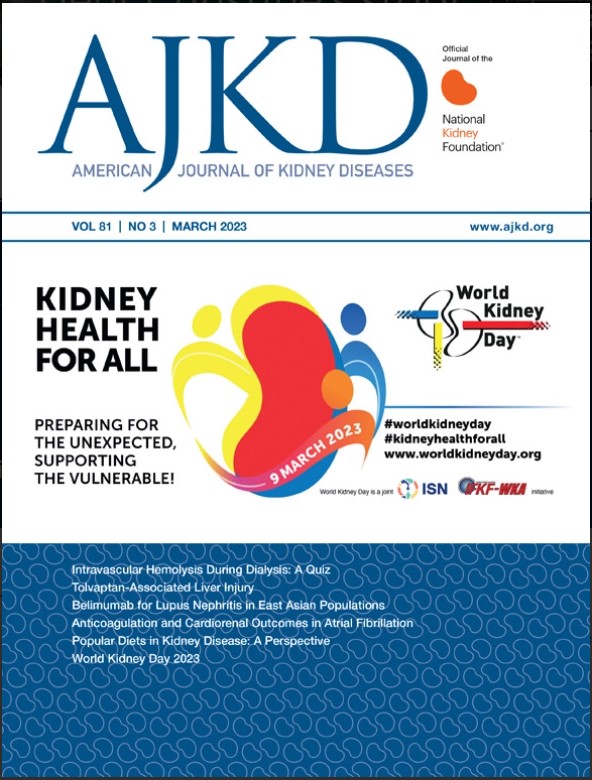Impact of the Type of Dialysate Acid Concentrate Container on the Environmental Footprint of Hemodialysis Centers.
IF 8.2
1区 医学
Q1 UROLOGY & NEPHROLOGY
引用次数: 0
Abstract
RATIONALE & OBJECTIVE Hemodialysis is the most common form of kidney replacement therapy and has a significant environmental footprint, raising sustainability concerns as demand increases. This study aimed at assessing the environmental impact of one aspect of the hemodialysis procedure, the type of container used for holding the acid concentrate that is used to prepare dialysate. STUDY DESIGN A retrospective cross-sectional life cycle assessment (LCA) of acid concentrate containers used in hemodialysis was conducted. SETTING & PARTICIPANTS Fifteen hemodialysis centers in three Spanish regions participated, representing approximately 5% of the national hemodialysis population. EXPOSURE Four acid concentrate container types from two manufacturers were assessed: canisters (3.9 L), flexible bags (4.2 L), and centralized storage tanks (300 L and 600 L). OUTCOMES The primary outcome was the environmental impact of each container, measured by carbon footprint (CO2eq in kg) and 16 additional environmental impact categories. ANALYTICAL APPROACH LCA was performed using OpenLCA software and Ecoinvent v3.10 database, considering the full life cycle of the containers, including production, transport, and waste disposal. RESULTS The 3.9 L canister had a carbon footprint 1.63-fold higher than the 4.2 L flexible bag and 2.63-fold higher than storage tanks (p<0.001). The main contributors to the carbon footprint were container production and waste disposal, particularly plastic usage and canister production and disposal. Storage tanks had the lowest carbon footprint (p<0.001), with no difference between 300 L and 600 L storage tanks. There were also significant differences in the environmental impact of different containers across 16 impact categories, with the largest differences observed for freshwater ecotoxicity, non-renewable energy use, and freshwater eutrophication. LIMITATIONS Assumptions regarding transport and disposal processes may introduce some variability. Additionally, financial costs were not assessed, which could influence container selection. CONCLUSION The choice of dialysate acid concentrate container is associated with a differential environmental impact. Thus, this study has identified a key potential approach to decrease the environmental impact of KRT.透析酸浓缩容器类型对血液透析中心环境足迹的影响。
理由与目的血液透析是肾脏替代疗法中最常见的一种形式,并且具有显著的环境足迹,随着需求的增加,引起了可持续性问题。本研究旨在评估血液透析程序的一个方面对环境的影响,即用于保存用于制备透析液的酸浓缩物的容器类型。研究设计对用于血液透析的酸浓缩容器进行回顾性横断面生命周期评估(LCA)。西班牙三个地区的15个血液透析中心参与了研究,约占全国血液透析人口的5%。对来自两家制造商的四种酸浓缩容器类型进行了评估:罐(3.9 L)、柔性袋(4.2 L)和集中储罐(300 L和600 L)。主要结果是每个容器的环境影响,通过碳足迹(二氧化碳当量单位千克)和16个额外的环境影响类别来衡量。分析方法采用OpenLCA软件和Ecoinvent v3.10数据库,考虑容器的全生命周期,包括生产、运输和废物处理。结果3.9 L罐的碳足迹比4.2 L柔性袋高1.63倍,比储罐高2.63倍(p<0.001)。造成碳足迹的主要因素是集装箱生产和废物处理,特别是塑料的使用和罐的生产和处理。储罐的碳足迹最低(p<0.001), 300升和600升的储罐之间没有差异。在16个影响类别中,不同容器的环境影响也存在显著差异,其中淡水生态毒性、不可再生能源使用和淡水富营养化差异最大。限制:关于运输和处置过程的假设可能会引入一些可变性。此外,没有评估财务成本,这可能会影响集装箱的选择。结论透析液浓缩液容器的选择与不同的环境影响有关。因此,这项研究已经确定了减少KRT对环境影响的关键潜在方法。
本文章由计算机程序翻译,如有差异,请以英文原文为准。
求助全文
约1分钟内获得全文
求助全文
来源期刊

American Journal of Kidney Diseases
医学-泌尿学与肾脏学
CiteScore
20.40
自引率
2.30%
发文量
732
审稿时长
3-8 weeks
期刊介绍:
The American Journal of Kidney Diseases (AJKD), the National Kidney Foundation's official journal, is globally recognized for its leadership in clinical nephrology content. Monthly, AJKD publishes original investigations on kidney diseases, hypertension, dialysis therapies, and kidney transplantation. Rigorous peer-review, statistical scrutiny, and a structured format characterize the publication process. Each issue includes case reports unveiling new diseases and potential therapeutic strategies.
 求助内容:
求助内容: 应助结果提醒方式:
应助结果提醒方式:


